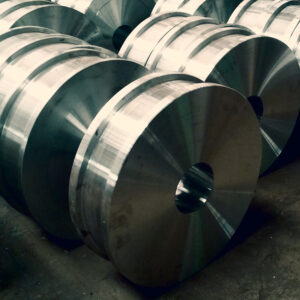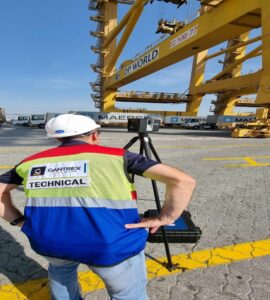THE GANTREX "INTRODUCING" SERIES #21
For real innovation to thrive you need 3 things: ideas, motivation, and time.
Lucian Wuillot has been responsible for the development of several key design support solutions that have greatly enhanced the efficiency and accuracy of internal processes and activities. Here he talks us through his main achievements and his recipe for innovation success.

Tell us a little about your career journey that brought you to Gantrex and what it is that keeps you committed to the organization.
I graduated from UCLouvain (Belgium) as a MSc Mechanical Engineer in 2013 and began my career as a consultant in the railway industry. I joined Gantrex in 2015 and have never looked back. In terms of the culture, one of the most rewarding aspects of working for Gantrex is the trust of the management that supports, approves and financially backs my ideas and initiatives. With that support and resource, numerous ideas have turned into reality, innovative concepts have become working systems. It’s a great reward witnessing the resulting improvements in our daily work.
I believe that for real innovation to thrive, a person, team or business need three things: ideas, motivation, and time. At Gantrex, we definitely have the first two, but, like most organizations, often lack the last one. However, the commitment to innovation and continuous improvement shown by our Management and Leadership is evident, as is the ability of our outstanding Technical Teams to deliver.
You have a strong internal reputation for being an innovator and have developed some tools that are now widely used including the Gantrex DesignDesk. Tell us about this tool and the rationale behind your design.
One of my first tasks when I started with Gantrex was to review the design and calculations of our Steel Columns and provide technical support for commercial projects involving this product. Working on this task quickly made me realize that we could greatly benefit from a tool that automates the design and calculation process. Therefore, as soon as I had some availability between ongoing projects, I started implementing the tool. This tool became the Gantrex DesignDesk, an internal web application used to streamline the design of tailor-made products within a defined frame.
Based on the project inputs, and predefined design rules, the application generates a design that can be customized further by our engineers to accommodate for the specifics of each project. Then, based on analytical calculations, it determines the product mechanical behaviour in various situations. Finally, it generates technical drawings for manufacturing and installation purposes, along with a fully detailed calculation note. The products covered by the application include rail supports, such as Steel Columns for railway pit tracks, but also track accessories like Trench Infill for crane tracks.
You also supported the development of our new test bench – could you explain the rationale and your approach to this?
To my knowledge, there are no established norms or recognized protocols for testing crane rail soft clips. Consequently, different entities use varying testing methods, resulting in non-comparable results. My idea was to observe the clip behavior under a pure lateral load. Using a pure lateral load has the advantage of being almost independent from the test bench and the test procedure used, making the results comparable and repeatable. However, this approach has the disadvantage of not being a load case we encounter in reality. Therefore, the values obtained are only meaningful when appropriately combined with other parameters. Obtaining a pure lateral load is not easy though. We needed to eliminate all friction, all rotations and all longitudinal and vertical displacements of the pseudo rail pushing against the tested clip. That lead to a new type of test bench, heavier, more complex, and more expensive than the ones previously used.
In developing both tools, you show a clear understanding of the work that colleagues must do. What other qualities and skills do you think you have that enable you to create innovative tools for other teams?
I believe that innovation often comes through the integration of different fields of expertise. DesignDesk is a good example in this context. I think it’s been successful because I had a good understanding of both the mechanical engineering work, and the programming aspects linked with the calculations and the application development. Designing and coding it myself internally meant that there was a lot of flexibility and timely access to user feedbacks. This facilitated the identification and implementation of improvements. I think some other key success factors were the attention to detail, strong project management, bringing together competent people, and giving enough time to implement properly.
For both DesignDesk and the new test bench, please tell us how these innovations feed into the customer’s experience?
The advantages of DesignDesk are multiple. The tool enables our teams to quickly design optimized products in detail, and to propose alternative designs, leading to better responsivity, better economics, and different options for our customers to choose from. Additionally, the time saved in the process for our engineers and draftsmen is significant, and it also reduces the risk of error.
The new Test Bench is an internal tool used to finely characterize the mechanical behaviour of our clips. For our customers, that means better products in the long-term and application optimized solutions.
The DesignDesk tool you created will play a major role in an upcoming development phase of the MyGantrex online customer portal. What difference do you think this new online portal will make for our customers?
DesignDesk will be integrated into the ‘MyGantrex’ customer portal through the ‘MyDesign’ section. I think its main value lies in supporting the initial stages of a project, where rapid sketching and iterative design processes are crucial. By completing a simple form, our customers will instantly receive a design proposal from the application, enabling them to quickly make well-informed decisions on their projects. The design tool and the new Portal in general are set to make significant impacts on overall customer experience. Market feedback for the Portal has already been hugely positive and the plans for next phase developments are axciting.
What would you like to look at next? Is there a new innovation that you and your colleagues are working on?
Yes, indeed ! There are a few active projects and many others planned for the future. I am currently working on ballasted crane tracks. After that, I would like to review our classic crane track calculation notes, as well as our clip nose compression rules. I have also devised a new clip concept that I would like to investigate further. In addition, I would like to implement more products into DesignDesk like steel plates, end-stops, and tiebacks. I think my ‘to do’ list is currently around two years long. As I mentioned previously, having the ideas is not the issue; however, finding the time to work on them can be challenging.
And finally what piece of advice would you give to someone looking to enter this industry and pursue a technical career such as yours?
We operate in a niche industry, and this almost forces us to innovate because of the specifics of the problems we face. In this context, imagination and resourcefulness are essential. Our teams are usually small, so being flexible and able to call on a wide range of skills is key. While it can be challenging at times, the wide variety of our work keeps our job interesting and engaging as we are consistently carrying out new and unique projects.






